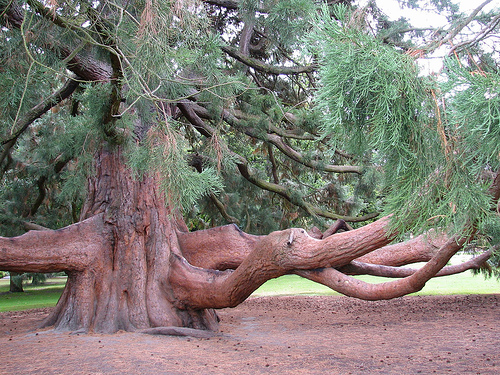I receive quite a few comments from people wishing they had trees in their area like they see in my videos.
The thing is I actually don’t think Seattle or the pacific north west is especially awesome for trees. I have simply been actively looking for good trees for 6 years and most people haven’t.
The predominant trees here are all very tall narrow crowned conifers, Douglas Firs, Western Red Cedar, Hemlock, Sitka Spruce, and Silver Fir, in general they form dense forests were the first limbs are quite high of the ground. There are of course exceptions but I would not say we are especially blessed with trees that are good for human movement here in the PNW.
When the limbs are low enough they do provide very sturdy limbs that can have a suitable amount of room between them for easy vertical climbing and other types of movement, but they are often unclimbable and rarely have limbs that are large enough and spaced fair enough apart to run on, or jump between.
In my six years of scouting in Seattle though I have found many good trees they hide among many trees that are less amenable to movement but the more I learn to move in trees the easier I find them.
I have traveled to teach or train in France, England, Italy, Corsica, San francisco, Los Angeles, Boulder, Denver, Columbus, Toronto, Vancouver, Portland, New York, New Jersey, Philadelphia, and I have found good trees for movement everywhere (though boulder is pretty sparse pickings).
There are exceptions of course deserts, true grasslands, and arctic environments aren’t going to offer much in the way of trees. But most of the worlds populations live in temperate areas where trees are common or if not where you can usually find them planted around towns and cities.
I have found a variety of types of trees good for human movement, low sprawling or weeping trees can offer amazing opportunities for flow over and on the branches with jumps, vaults, and tic tac techniques.
The trees at volunteer park are western red Cedar and given open space Red Cedars will crown from their base to providing very interesting environments, they also have very strong and flexible limbs.
Uncommon in the northwest but common throughout California, the south, the east coast and much of Europe, Oak trees often form a spreading and low to the ground crown that offers amazing potential for movement. Like in this video from Chatsworth park in LA(a place most people would not think of for trees).
My Favorite trees when visiting the east coast are Beech trees which are also common in Europe they provide really strong limbs in interesting shapes and often crown low or weep back to the ground and sprout back up creating complex movement areas. Some of the best jumps at height between tree limbs I have found were in beach trees.
Like you seen in this video.
If your in a tropical region banyan trees will do the low sprawling thing as well as lots of other fascinating formations for movement.
Willows make will create wonderful shapes along these lines frequently as well. Like the one I found in Denver here.
View this post on InstagramA nice tree line from Washington park #evolvemoveplay
A post shared by Natural Movement Coach (@rafekelley) on
True Cedars of the genus Cedras which are common in the Mediterranean and planted in parks worldwide are also great for this type of movement.
https://humphrysfamilytree.com/Herbert/Bitmaps/wilton.18.full.jpg
One the west coast, Sequoia trees are usually better for straight climbing the but the first good sprawling tree I ever found was actually a sequoia and they to can produce some diverse and fantastic shapes.

Another interesting movement environment is produced by lower shrubby trees which grow grow close enough and with enough variety in shape to move easily from one to another, like this video from Daniel Ilabaca
My favorite for this type of movement in the northwest are english Laurels there invasive here and common throughout the temperate US and Europe.
Beech trees can do this too, other types of laurel, rhododendrons, and many more do as well I am not sure what kind of trees these are but I found them at baker beach in SF and they were amazing.
View this post on InstagramA post shared by Natural Movement Coach (@rafekelley) on
There are trees that are good for movement in branches up above head height, including beech, sycamore, cedar, some firs, spruces, larches, pines. Like the silver fir in my video above, here you want strong branches, and space to swing, climb and move between them.
I believe Scots pines are the trees featured in the humanzee videos which I love
One final category I would add are trees that are good for trunk climbing without using the limbs these can be slender trunks like palm trees that you climb using a cat hang type movement with hands hooked behind the tree or the can be large trunks with big knobs on them that can be climbed like boulder problems. Lately I have been finding allot of big leaf maples where I can do bouldering style climbing challenges up into them.
There is much more to say about the specific types of trees and ways to move in trees it is very large subject but I will cover those in later posts. For now you should be able to find examples of some of the types trees I highlighted were you live, go get to know them.




